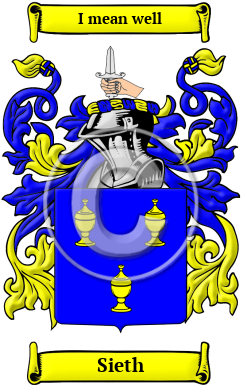| ![Show Contents]() Sieth History, Family Crest & Coats of Arms Sieth History, Family Crest & Coats of Arms
- Origins Available:
Scotland
Ireland
Etymology of SiethWhat does the name Sieth mean? The clans of the ancient Scottish Pictish tribe were the ancestors of the first person to use the name Sieth. It was name for a person who shared some of the qualities attributed to a wolf. Sieth is a nickname surname, which belongs to the category of hereditary surnames. Nicknames form a broad and miscellaneous class of surnames, and can refer directly or indirectly to one's personality, physical attributes, mannerisms, or even their habits of dress. The surname Sieth is derived from the Gaelic first name Sithech, which means wolf. Early Origins of the Sieth familyThe surname Sieth was first found in Perthshire (Gaelic: Siorrachd Pheairt) former county in the present day Council Area of Perth and Kinross, located in central Scotland, where the family appears to have been firmly entrenched in the Eastern coastal regions well before 1000 AD. While some claim that the Clan originally descended from a MacDuff, one of the ancient Earls of Fife, the first official mention in documents shows them to be present at the General Council held by King Malcolm at Forfar in 1061. However, this ancient leadership was challenged by many other Clans Commyns (Cummings) who had leased the Shaw lands of Rothiemurchus. Early History of the Sieth familyThis web page shows only a small excerpt of our Sieth research. Another 369 words (26 lines of text) covering the years 1178, 1226, 1405, 1411, 1527, 1550, 1602, 1608, 1625, 1672, 1692, 1751, 1774, 1776, 1799, 1804, 1826, 1832, 1849, 1876 and 1890 are included under the topic Early Sieth History in all our PDF Extended History products and printed products wherever possible. Sieth Spelling VariationsScribes in the Middle Ages did not have access to a set of spelling rules. They spelled according to sound, the result was a great number of spelling variations. In various documents, Sieth has been spelled Shaw, Shawe, Mac Ghille-Sheathanaich (Gaelic) and others. Early Notables of the Sieth familyNotable amongst the Clan at this time was Robert Shaw (died 1527), Scottish cluniac monk and prelate; William Schawe (1550-1602), Scottish architect, probably a younger son of Schaw of Sauchie; John Shawe or Shaw (1608-1672), an English puritan minister from Yorkshire...
Another 41 words (3 lines of text) are included under the topic Early Sieth Notables in all our PDF Extended History products and printed products wherever possible. Migration of the Sieth family to IrelandSome of the Sieth family moved to Ireland, but this topic is not covered in this excerpt.
Another 123 words (9 lines of text) about their life in Ireland is included in all our PDF Extended History products and printed products wherever possible. Migration of the Sieth familyThe cruelties suffered under the new government forced many to leave their ancient homeland for the freedom of the North American colonies. Those who arrived safely found land, freedom, and opportunity for the taking. These hardy settlers gave their strength and perseverance to the young nations that would become the United States and Canada. Immigration and passenger lists have shown many early immigrants bearing the name Sieth: Anne Shaw settled in Virginia in 1635; along with Richard and William; Donald Shaw settled in Virginia in 1716; Ewen Shaw settled in South Carolina in 1716.
The motto was originally a war cry or slogan. Mottoes first began to be shown with arms in the 14th and 15th centuries, but were not in general use until the 17th century. Thus the oldest coats of arms generally do not include a motto. Mottoes seldom form part of the grant of arms: Under most heraldic authorities, a motto is an optional component of the coat of arms, and can be added to or changed at will; many families have chosen not to display a motto.
Motto: I mean well
 |

